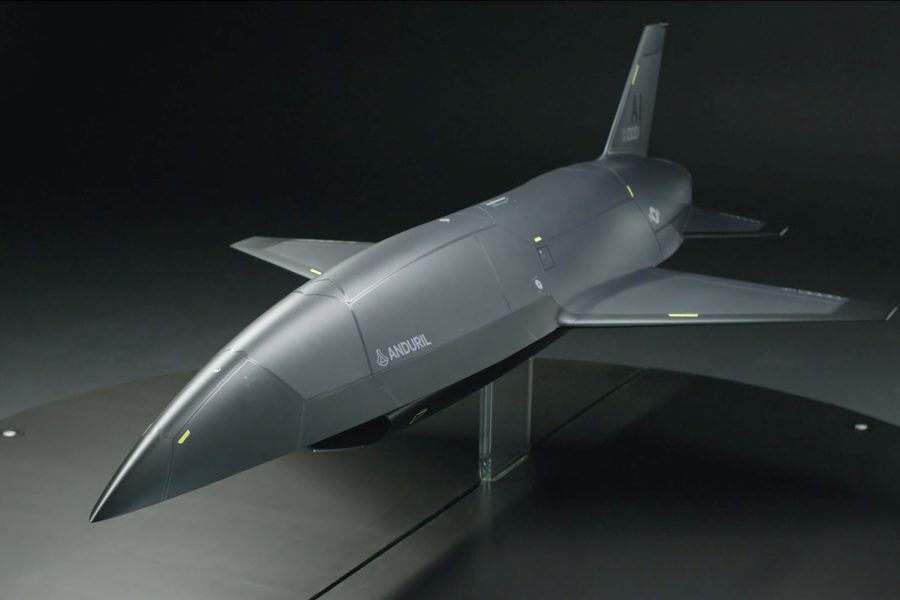Anduril Industries—one of the two companies selected by the Air Force to develop the first increment of Collaborative Combat Aircraft—announced it will soon build a factory designed to produce a variety of autonomous weapons, including CCAs, “at scale.”
Anduril has not yet settled on a site for its factory, dubbed “Arsenal,” but it will be in the U.S. and a rapidly-reconfigurable facility designed to swiftly build “autonomous systems and weapons of all classes,” company chief strategy officer Chris Brose told reporters. He characterized the weapons to be built as not “exquisite” all-in-one systems but complementary capabilities for other platforms.
The company is “never going to focus on building exquisite weapons systems. We are going to focus on building what we believe is the sort of supplementary capabilities that we can get quickly,” Brose said.
The company’s offering in the CCA competition—the “Fury”—was originally intended to be a stealthy, jet-powered sparring partner for Air Combat Command’s fifth-generation F-22s and F-35s. It will be one of the products to be built at Arsenal, along with loitering munitions, electronic warfare systems, and autonomous submarine vehicles. All of the company’s products will be built “under one roof,” Brose said.
The factory will rely heavily on software to speed processes and attract workers. It is intended to employ “thousands of people” across “more than five million square feet of production space,” he said.
“Moving to larger-scale production is a journey that Anduril has been on for the past few years,” Brose said. A second factory is meant to follow in close order, he said; it may be located in an allied country such as Australia.
Brose said the factory—named to echo the “Arsenal of Democracy” of World War II—is being undertaken because “America and our allies don’t have enough stuff, right? We don’t have enough vehicles, we don’t have enough platforms, we don’t have enough weapons. This has been true for a long time.” The war in Ukraine has highlighted that the U.S. is “struggling to do basic things like replace Stingers and Javelins.” Wargames focused on a Pacific conflict “have suggested for years that we would run out of critical munitions in the first week of a conflict,” and the weapons used are not easily or quickly replaced.
“We have been building and sort of sizing the military around a relatively small number of things,” Brose said. “And over time, we have made those things effectively irreplaceable, because of how exquisite we have defined the requirements, the manufacturing processes that go into producing them, the highly specialized labor that is required to produce them.”
The Arsenal factory is meant to reverse that trend.
“Our view on this is we need those exquisite platforms in some number, but we just don’t have the time, the money, the specialized workforce, and all of the other things that would be required to scale it to the degrees that we actually require to generate deterrence against great power competitors,” Brose said.
The explanation closely follows Deputy Defense Secretary Kathleen Hicks’ description of her “Replicator” effort, launched last year and focused on things the Pentagon is already buying.
Brose said the company has raised $1.5 billion for Arsenal and related efforts.
He noted there are traditional benefits to distributing military manufacturing across a number of congressional districts, but the “benefits we can achieve from a manufacturing standpoint through consolidation outweigh whatever kind of political benefits we might get” from a distributed strategy.
The company aims to build “not just … shorter-range systems that are so commonplace in Ukraine, but longer-range, larger-payload sort of more survivable autonomous systems and weapons that are going to be more appropriate for INDOPACOM contingencies,” Brose said.
The U.S. military need these “in the tens of thousands” and that is the scale the company envisions, citing the example of commercial companies like Tesla, SpaceX, and and Apple.
That manufacturing “revolution” has “passed the defense industrial base by,” but Anduril believes it can work for the military as well, Brose said.
Using the company’s Lattice open software architecture, “we can actually own the architecture of everything that we are building and control it. This is very different than how traditional defense production is, where software is broken up across lots of different subcomponents and balkanized across the platform,” Brose said.
“What Lattice gives us is the ability to start with a mature software platform, and then build modular, producible weapons from it, where we can control how all of the different subsystems interface into the overall platform, whether its mission systems, radios, computers.”
The manufacturing process won’t focus on additive manufacturing or any one new method but instead hone in on automated processes, Brose said.
“A core lesson that we take out of the commercial manufacturing revolution is that it’s succeeding not because they automated everything, or they AI their way out of it, or advanced manufactured their way out of these traditional problems. It’s actually that they stood up production lines to take advantage of manufacturing products as simply as possible with the broadest commercial supply chains available, utilizing the broadest workforce possible,” he said.


